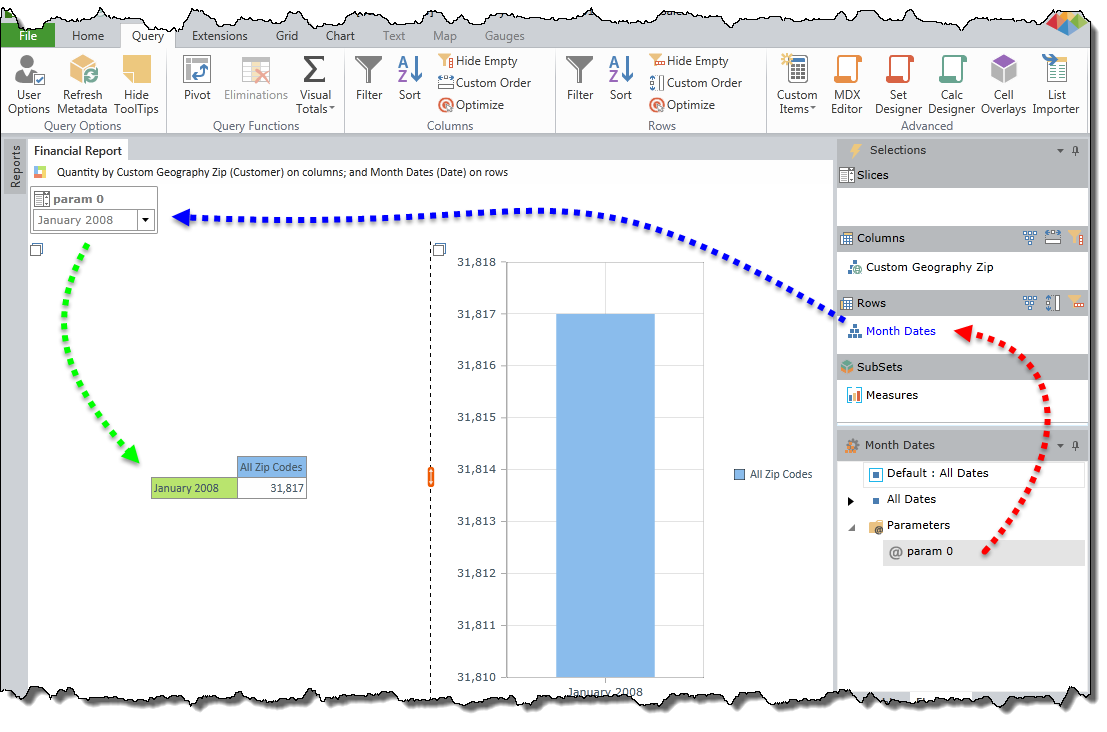Parameters Overview
The patent-pending parameter functionality in BI Office offers end users the unprecedented ability to build complex queries that are not often possible in typical analytical clients. In effect, the usage of parameter functionality allows end users to build parameter slicers to feed dynamic elements into a query instead of the typical "where" part of the query.
The key benefits of this functionality is to allow users to change sophisticated logic built into queries at runtime without having to design complex artifacts in the cube structure on the server and without using software development kits (SDKs) on the client.
Parameters expose a number of clever calculation capabilities and are critical to delivering cascading prompts/slicers and waterfall effects in the data.
NOTE: The functional parameters should not be confused with "URL Parameters" which allow users to feed selections into a report using the External URL technique for loading up a report. URL Parameters can be used as source inputs for these functional parameters, which effectively act as targets in a query.
To better understand the use of parameters, be sure to see the parameter examples.
Creating Parameters
To create a parameter, the user can either use the element tree quick menu or the right-click context menu within the element tree. The user will be prompted with a parameter member selection dialog (see image below) where the user supplies:
- A name for the parameter.
- A brief description of usage and content.
- The selection of the members that will be used to populate the parameter's input list in the slicer (red highlight below).
- The default member (red arrow below) that will be used when the parameter is initialized. The default element is used to populate the target query until a user makes a different choice.

Parameter Usage
Once designed and added to a report, parameters can be used in:
- Queries, as normal elements.
- Queries, with derivative functions such as descendants and children.
- Custom members and sets.
- Targets for interactions which are designed and deployed in the Story Board application.
- Targets for URL parameters, fed into the report via the external URL address.
Once created, parameters appear as normal elements in the element trees. Users simply select them as normal elements for the dimensions currently held in the rows or columns (red arrow below). This will trigger the creation of a matching slicer listing (blue arrow below). When the query is run, the parameter on the row or column axis is replaced with the current slicer selection (green arrow).
NOTE: Parameterized hierarchies are highlighted blue in the selections tree.
NOTE: Users can create one or more parameters for a given hierarchy. Each parameter will trigger a separate slicer list and will, in turn, appear in the result set.

Edit and Deleting Parameters
Right clicking on a parameter will expose several context menus for managing the parameter. The menus allow you to edit parameter settings, delete parameters and duplicate parameters.
Using Parameters inside an "ASD" Set
One of the more powerful analytic features of Data Discovery relates to using parameters inside sets designed with the Advanced Set Designer wizard. Use of parameters allows users to change the definitional construct of an ASD set at run time by using the parameter slicers - rather than having to manually edit values within the ASD definition itself. See Advanced Set Designer for more information. Another such example relates to cascading slicers.
Multi-Mode
Multi-mode is a special flag for parameterized calculations. Multi-mode allows users to customize the way multi-select parameters operate inside custom elements: either on an iterative basis (default) or cumulative basis.
Home |
Table of Contents |
Index |
User Community
Pyramid Analytics © 2011-2022

